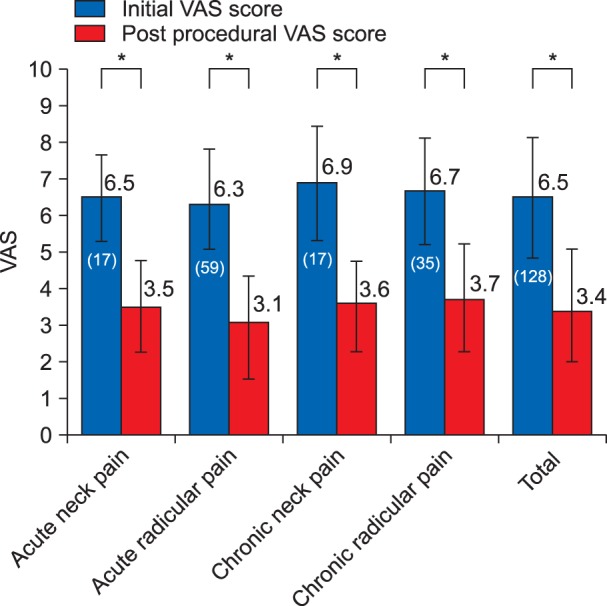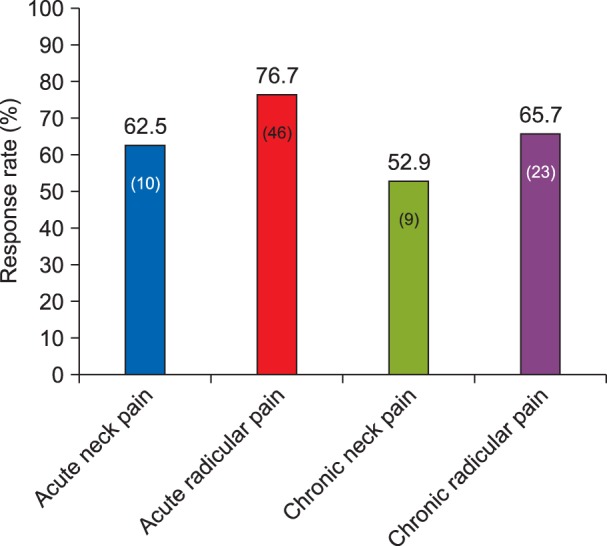Effect of Cervical Interlaminar Epidural Steroid Injection: Analysis According to the Neck Pain Patterns and MRI Findings
- Affiliations
-
- 1Department of Anesthesiology and Pain Medicine, Samsung Medical Center, Sungkyunkwan University School of Medicine, Seoul, Korea. wooseog.sim@samsung.com
- 2Zein (ZEropaIN) Pain Treatment Clinic, Seoul, Korea.
- KMID: 2365351
- DOI: http://doi.org/10.3344/kjp.2016.29.2.96
Abstract
- BACKGROUND
It is widely accepted that cervical interlaminar steroid injection (CIESI) is more effective in treating radicular pain than axial neck pain, but without direct comparison. And the differences of effect after CIESI according to MRI findings are inconsistent. In this retrospective study, we evaluated the therapeutic response of CIESI according to pain sites, durations, MRI findings, and other predictive factors altogether, unlike previous studies, which evaluated them separately.
METHODS
The medical records of 128 patients who received fluoroscopy guided CIESI were analyzed. We evaluated the therapeutic response (more than a 50% reduction on the visual analog scale [VAS] by their second visit) after CIESI by (1) pain site; neck pain without radicular pain/radicular pain with or without neck pain, (2) pain duration; acute/chronic (more than 6 month), and (3) findings of MRI; herniated intervertebral disc (HIVD)/spinal stenosis, respectively and altogether.
RESULTS
Eighty-eight patients (68%) responded to CIESI, and there were no significant differences in demographic data, initial VAS score, or laboratory findings. And there were no significant differences in the response rate relating to pain site, pain duration, or MRI findings, respectively. In additional analysis, acute radicular pain with HIVD patients showed significantly better response than chronic neck pain with spinal stenosis (P = 0.04).
CONCLUSIONS
We cannot find any sole predictive factor of therapeutic response to the CIESI. But the patients having acute radicular pain with HIVD showed the best response, and those having other chronic neck pain showed the worst response to CIESI.
Keyword
MeSH Terms
Figure
Cited by 4 articles
-
Sufficient explanation of management affects patient satisfaction and the practice of post-treatment management in spinal pain, a multicenter study of 1007 patients
Jae Yun Kim, Jae Hang Shim, Sung Jun Hong, Jong Yeun Yang, Hey Ran Choi, Yun Hee Lim, Ho Sik Moon, Jaemoon Lee, Jae Hun Kim
Korean J Pain. 2017;30(2):116-125. doi: 10.3344/kjp.2017.30.2.116.Effect of epidural corticosteroid injection on magnetic resonance imaging findings
Min Soo Kim, Tae Yoon Jeong, Yu Seon Cheong, Young Wook Jeon, So Young Lim, Seong Sik Kang, In Nam Kim, Tsong Bin Chang, Hyun Ho Seong, Byeong Mun Hwang
Korean J Pain. 2017;30(4):281-286. doi: 10.3344/kjp.2017.30.4.281.Association between fatty infiltration in the cervical multifidus and treatment response following cervical interlaminar epidural steroid injection
Hyun-Jung Kwon, Chan-Sik Kim, Sungwon Kim, Syn Hae Yoon, Jungho Koh, Young Ki Kim, Seong-Soo Choi, Jin-Woo Shin, Doo-Hwan Kim
Korean J Pain. 2023;36(3):358-368. doi: 10.3344/kjp.23092.Complications and safety of cervical interlaminar epidural block
Jae Hun Kim
Korean J Pain. 2024;37(3):185-187. doi: 10.3344/kjp.24186.
Reference
-
1. Rowlingson JC, Kirschenbaum LP. Epidural analgesic techniques in the management of cervical pain. Anesth Analg. 1986; 65:938–942. PMID: 3017152.
Article2. Manchikanti L, Abdi S, Atluri S, Benyamin RM, Boswell MV, Buenaventura RM, et al. An update of comprehensive evidence-based guidelines for interventional techniques in chronic spinal pain. Part II: guidance and recommendations. Pain Physician. 2013; 16(2 Suppl):S49–S283. PMID: 23615883.3. Diwan S, Manchikanti L, Benyamin RM, Bryce DA, Geffert S, Hameed H, et al. Effectiveness of cervical epidural injections in the management of chronic neck and upper extremity pain. Pain Physician. 2012; 15:E405–E434. PMID: 22828692.4. Manchikanti L, Boswell MV, Singh V, Benyamin RM, Fellows B, Abdi S, et al. Comprehensive evidence-based guidelines for interventional techniques in the management of chronic spinal pain. Pain Physician. 2009; 12:699–802. PMID: 19644537.5. Benzon HT. The long journey of epidural steroid injections. Reg Anesth Pain Med. 2013; 38:171–172. PMID: 23598726.
Article6. Manchikanti L. Role of neuraxial steroids in interventional pain management. Pain Physician. 2002; 5:182–199. PMID: 16902669.
Article7. Huston CW. Cervical epidural steroid injections in the management of cervical radiculitis: interlaminar versus transforaminal. A review. Curr Rev Musculoskelet Med. 2009; 2:30–42. PMID: 19468916.
Article8. Stout A. Epidural steroid injections for cervical radiculopathy. Phys Med Rehabil Clin N Am. 2011; 22:149–159. PMID: 21292151.
Article9. Benyamin RM, Singh V, Parr AT, Conn A, Diwan S, Abdi S. Systematic review of the effectiveness of cervical epidurals in the management of chronic neck pain. Pain Physician. 2009; 12:137–157. PMID: 19165300.10. Cohen SP, Bicket MC, Jamison D, Wilkinson I, Rathmell JP. Epidural steroids: a comprehensive, evidence-based review. Reg Anesth Pain Med. 2013; 38:175–200. PMID: 23598728.11. Ferrante FM, Wilson SP, Iacobo C, Orav EJ, Rocco AG, Lipson S. Clinical classification as a predictor of therapeutic outcome after cervical epidural steroid injection. Spine (Phila Pa 1976). 1993; 18:730–736. PMID: 8516703.
Article12. Stav A, Ovadia L, Sternberg A, Kaadan M, Weksler N. Cervical epidural steroid injection for cervicobrachialgia. Acta Anaesthesiol Scand. 1993; 37:562–566. PMID: 8213020.
Article13. Catchlove RF, Braha R. The use of cervical epidural nerve blocks in the management of chronic head and neck pain. Can Anaesth Soc J. 1984; 31:188–191. PMID: 6704782.
Article14. Saal JS, Saal JA, Yurth EF. Nonoperative management of herniated cervical intervertebral disc with radiculopathy. Spine (Phila Pa 1976). 1996; 21:1877–1883. PMID: 8875719.
Article15. Lee SH, Kim KT, Kim DH, Lee BJ, Son ES, Kwack YH. Clinical outcomes of cervical radiculopathy following epidural steroid injection: a prospective study with follow-up for more than 2 years. Spine (Phila Pa 1976). 2012; 37:1041–1047. PMID: 22024908.
Article16. Kwon JW, Lee JW, Kim SH, Choi JY, Yeom JS, Kim HJ, et al. Cervical interlaminar epidural steroid injection for neck pain and cervical radiculopathy: effect and prognostic factors. Skeletal Radiol. 2007; 36:431–436. PMID: 17340166.
Article17. Shakir A, Ma V, Mehta B. Prediction of therapeutic response to cervical epidural steroid injection according to distribution of radicular pain. Am J Phys Med Rehabil. 2011; 90:917–922. PMID: 21955951.
Article18. Fish DE, Kobayashi HW, Chang TL, Pham Q. MRI prediction of therapeutic response to epidural steroid injection in patients with cervical radiculopathy. Am J Phys Med Rehabil. 2009; 88:239–246. PMID: 19106793.
Article19. Annaswamy TM, Bierner SM, Avraham R. Role of electrodiagnosis in patients being considered for epidural steroid injections. PM R. 2013; 5(5 Suppl):S96–S99. PMID: 23524071.
Article20. Ackerman WE 3rd, Zhang JM. Serum hs-CRP as a useful marker for predicting the efficacy of lumbar epidural steroid injections on pain relief in patients with lumbar disc herniations. J Ky Med Assoc. 2006; 104:295–299. PMID: 16886882.21. Borghouts JA, Koes BW, Bouter LM. The clinical course and prognostic factors of non-specific neck pain: a systematic review. Pain. 1998; 77:1–13. PMID: 9755013.
Article22. Manchikanti L, Cash KA, Pampati V, Malla Y. Two-year follow-up results of fluoroscopic cervical epidural injections in chronic axial or discogenic neck pain: a randomized, double-blind, controlled trial. Int J Med Sci. 2014; 11:309–320. PMID: 24578607.
Article23. Kim KT, Song CW. Radiologic finding of patients with neck pain. J Korean Pain Soc. 1996; 9:102–104.24. Park CH, Lee SH. Investigation of high-sensitivity C-reactive protein and erythrocyte sedimentation rate in low back pain patients. Korean J Pain. 2010; 23:147–150. PMID: 20556218.
Article25. Dworkin RH, O'Connor AB, Kent J, Mackey SC, Raja SN, Stacey BR, et al. Interventional management of neuropathic pain: NeuPSIG recommendations. Pain. 2013; 154:2249–2261. PMID: 23748119.
Article26. Kang H, Shin HY. Epidural steroid injection in spinal pain: a study on the NECA report. Anesth Pain Med. 2014; 9:9–18.
- Full Text Links
- Actions
-
Cited
- CITED
-
- Close
- Share
- Similar articles
-
- Management of Cervical Radiculopathy with Epidural Steroid Injection
- Epidural Steroid Injection
- Delayed Pneumocephalus Following Fluoroscopy Guided Cervical Interlaminar Epidural Steroid Injection: A Rare Complication and Anatomical Considerations
- Epidural Steroid Injection in the Treatment of Cervical Radiculopathy
- Oblique interlaminar lumbar epidural steroid injection for management of low back pain with lumbosacral radicular pain: A case report




